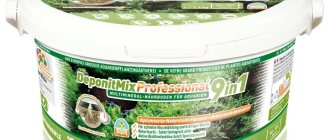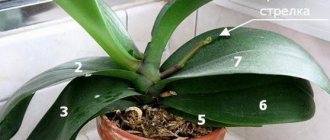For many centuries, European flower growers have been haunted by this question. Therefore, a topic that can easily lift the spirits of a group of orchid lovers is choosing the right substrate for orchids.
This is an important and responsible choice, since planting in an unsuitable substrate can result in the death of the plant.
Is it possible to plant an orchid in plain soil?
To begin with, it is worth knowing that the Orchid family has more than 35,000 species. Among them there are a wide variety of specimens that are able to adapt to any environmental conditions, including soil.
The Orchid family can be divided into several classes according to their mode of existence:
- epiphytes;
- lithophytes;
- terrestrial orchids.
Epiphytes are plants that grow in tropical and subtropical conditions. They prefer to settle on other plants, without parasitizing at their expense. They can be found in the crown of trees, hollows, and forks. Developing in such conditions, these types of orchids receive more light and nutrients than growing below on the soil on their own. They get their food from humus, which is located on tree trunks, and absorb moisture after rain.
Lithophytes are well adapted to life in rocky areas, where mosses and lichens provide good soil for them. At the initial stage of development of these plants, they have enough nutrition, but then they take useful substances from their own dead cells and the remains of mosses and fungi.
Terrestrial orchids grow in temperate climates and inhabit mid-latitudes. But among them there are also many tropical types of crops. Some of them grow well in rocky areas, which makes them look like lithophytes.
When choosing a substrate in a flower shop, you need to pay attention to the composition and structure of the soil in the bag. It shouldn't be a single lump. When planting, you should check whether the substrate contains mold, dust, or foreign inclusions.
Thus, you can plant orchids in plain soil if it contains the mycelium necessary for the plant, with which you can enter into symbiosis.
How to make it yourself at home?
It is easy to prepare the substrate at home thanks to the Internet and the knowledge gained. The magnitude of the components is directly proportional to the thickness of the roots: thicker - larger.
What does it include?
The components of homemade soil are similar to store-bought ones. Includes:
- spruce or pine bark;
- moss;
- charcoal;
- peat;
- fern root.
The composition is prepared before transplantation. Do not pre-mix the soil.
Comparison with purchased
When comparing soils: from a store and your own, it is impossible to give an assessment. In the store, the proportions and rules of preparation are already strictly observed. The ingredients are natural, but the quality does not always meet expectations. You will be confident in the substrate made at home.
However, there is an obstacle - not all components are easy to obtain. The best option for phalaenopsis is a product from the store with the addition of its own components.
Advantages and disadvantages
Pros of making homemade soil:
- budget cost;
- high and reliable quality;
- selection of components specifically for the plant variety;
- maintaining proportions.
There are fewer disadvantages of such soil, but they exist:
- Some components are difficult to obtain.
- Another drawback concerns pine bark. There is a possibility of bringing insects into the house, and the search and preparation of bark itself is a difficult process.
Where can I get the components?
Pine bark can be obtained from the forest, preferably from or near felled trees. So the amount of resins will be less. Coal is one of the simplest components. It can be found at the site of the fire after tourists have rested.
Peat is difficult to obtain, so it can be purchased in specialized stores. Minor components for the soil are also collected from the forest.
Important! Sphagnum moss can be found in deep holes. However, you need to be careful when collecting, as there is a risk of falling 15-20 meters
Another way to get the plant is in small swamps after the snow melts in the spring. Moisture promotes moss growth. Deciduous soil is rotted leaves or a decomposed layer of old pine needles.
How to make: step-by-step instructions
To make the substrate you will need a spatula, scissors, a knife and bags. It will take some time to prepare the components:
- The moss should be soaked in water for one day and then dried.
- The bark is crushed into chips and sterilized in a steam bath for half an hour. Next - dry.
- The coal is crushed into two centimeter pieces.
- Peat is also divided into small particles.
- The fern root is washed in warm water, poured with boiling water and then dried.
Popular methods for preparing the substrate:
- Coal and bark in a ratio of 1:5.
- Coal, moss, pine chips in a ratio of 1:2:5.
- Peat and bark in equal proportions with ⅓ of deciduous soil.
The finished soil should not be too dense.
Have you decided to buy a phalaenopsis? We recommend that you look at our articles about what care is needed after purchasing it in a store, what are the rules for watering and how often to do it, how to feed the plant, and also how to separate the baby from the peduncle, stem and root.
Why are many types of orchids contraindicated in ordinary soil?
In those days, when the orchid was a new thing for many gardeners, and no one knew about the conditions of its maintenance, the flower was planted in ordinary soil for indoor plants. It is not surprising that the exotic plant soon died. Perhaps from that moment on they began to believe that the orchid was very capricious. Then flower growers realized that the crop does not tolerate dense soil. The orchid's root system is designed in such a way that it constantly needs air access.
Deprived of this in ordinary soil, under the pressure of stagnant water, the orchid becomes easy prey for microorganisms that affect the roots of the plant. The process of decay begins in the tissues and, having lost the roots, the orchid dies.
What to plant an orchid in: choosing soil and container
Adding an article to a new collection
Orchids are epiphytes that naturally grow on trees that serve as their support. Such plants breathe and feed through their roots. Therefore, for a flower, the air permeability of both the soil and the pot in which they are grown is of great importance.
In our country, orchids are considered capricious plants, but in their homeland they are planted everywhere: on thatched roofs, in ceramic pipes, in empty wooden baskets, and simply nailed or tied to mossy fences. The main condition is that they have enough air, moisture, nutrition, and the sun does not burn them.
Our climate leaves its mark on the cultivation of this exotic flower. Providing him with a whole tree to live in an apartment is an impossible task, but it can be replaced with bark, which forms the basis of the substrate for orchids. It also includes other components.
Do I need to add soil to the soil?
Many people know that planting an orchid in ordinary soil means soon losing the plant, but the question arises whether it is possible to add soil to the soil. Based on what species the orchid belongs to, you need to select the appropriate substrate. However, if the plant is not adapted to ordinary soil, then it is better not to risk the health of the flower.
If the owner knows what variety his orchid belongs to and is confident that it can grow in ordinary soil, then you can prepare a similar mixture yourself.
The classic substrate for orchids should consist of tree bark, with the culture preferring coniferous or a mixture of oak and beech. This composition copes with the delivery of moisture, air and firmly secures the plant in the pot. Moss is necessary to maintain the required level of moisture. In addition, it has bactericidal properties that a tropical plant needs. However, it must be changed at least once a year. Also, the amount of moss is reduced in winter. Charcoal is needed by plants as a sorbent, but it is added to the mixture in limited quantities - no more than 10% of the total mass.
Preparing the mixture yourself requires maintaining the correct proportions. For each variety, the ratio is selected individually.
When is the right time to transplant at home?
In what soil should Kalanchoe medicinal be planted?
You can replant an orchid at home in a dormant state, but there are no clear restrictions, since the culture develops throughout the year, leaves and roots form. There are several periods that are most favorable for performing such a procedure.
- Spring. For home crops, spring begins already in February and ends with the onset of heat.
- The period of awakening after winter. It is better to transplant the orchid into another pot after the heating is turned off. At this time growth is activated.
- The rest period after flowering is optimal for replanting an orchid. However, it is better not to plant during flowering. They wait until the flower stalks fall off, and only then change the nutrient soil and pot.
When performing the procedure, adhere to the rules and the classical sequence of actions.
Replanting after shopping in a store
After purchasing a new orchid, you should inspect the purchase and determine whether a transplant is necessary.
- After purchasing, it is simply necessary to replant the orchid if there is damage to the pot.
- Inspect all roots. A healthy root system is silver in color when dry, and green when wet. If they are not visible, rot is present, then an emergency transplant is performed.
- Most often, orchids are sold in an unsuitable substrate. There may also be additives in the form of peat, coconut fibers, and foam rubber. They accumulate moisture, which negatively affects the flower.
Note! If the roots are hard to see, then carefully crush the plastic container and lift the plant out of the pot.
If an orchid bought in a store looks great and nothing causes alarm, then there is no need to disturb the culture again.
Replanting an orchid with flowers
Many people are concerned about the question of whether it is possible to replant an orchid in the fall during the flowering period. Transplanting Phalaenopsis with flowers is very stressful. But if there is an urgent need, if there is no other option, they are transplanted. It is best to perform transshipment without compromising the integrity of the root system. This applies to situations where there is little room for culture.
During the flowering period, Phalaenopsis should be replanted if the roots are damaged or rotting. Trimming dead or rotten roots will have a bad effect on flowering, so it is better to remove the peduncle completely or cut it to a dormant point. The orchid will bloom again next year.
In a glass vase
Using a glass vase as a flowerpot is an original method of transplantation. The advantage of this option is that the plant practically does not need to be watered, since moisture from the bottom is absorbed into the soil.
Note! The success of cultivation in a glass vase depends on the container and compliance with the conditions of the procedure. This requires knowledge and experience.
Roots grow very quickly in glass vases. Outwardly, they may resemble a beard.
Old orchid
There is no fundamental difference in transplanting orchids of different ages. You just need to be extremely careful when replanting an old crop.
This is due to the fact that the roots are too developed and are easy to damage. When transplanting adult flowers, the same technologies are used as for young crops.
Note! The most difficult process is the process of transplanting mini-orchids. To transplant a mini orchid, you need maximum care, since this variety is very fragile.
Phalaenopsis babies
When transplanting an adult culture, you can find a young shoot with leaves and developed roots. Young plants are also replanted. Take a smaller pot.
The sequence of actions is no different from transplanting an adult flower. First, a layer of drainage is poured into the container, then the washed root system is carefully placed. Holding the orchid, sprinkle the roots with soil on top. Shake the container slightly so that the soil spreads into all empty spaces.
Preparation of growing substrate
Usually the following components are used to suit the orchid. You need a soil base of leaves, turf, coniferous soil or peat, as well as elements that will add looseness, for example, polystyrene foam, moss, tree bark. Don't forget about organic fertilizers.
When using a substrate prepared independently, you should understand that the correct level of acidity is required, without which it will be difficult for the orchid to develop. Another very important point concerns microorganisms that can live in prepared soil. All components from flower shops have been heat-treated and properly disinfected, this reduces the risk of developing diseases and insects.
How to cook it yourself?
Experienced gardeners consider preparing the substrate at home to be quite a difficult task. The main problem is the acquisition of basic and auxiliary ingredients, which must be environmentally friendly and of high quality. In this case, some components for a homemade soil mixture will have to be modified manually. This primarily concerns pine bark and cones, which contain a large amount of resin.
Both the bark and the cones should be subjected to heat treatment before preparing the mixture, for which the components are boiled for several hours. After boiling, the bark and cones are thoroughly dried and crushed into pieces 1-2 centimeters in size.
Sphagnum, which is the basic component, can be purchased at a specialty store. Before preparing the substrate, it should be soaked in water for a couple of hours.
To make the soil mixture for orchids breathable, sphagnum, coarse sand, dry fern roots, coconut fiber, and cork are added to the pine bark fractions. To provide additional nutrition to plant roots, it is recommended to add peat and leaf humus to the mixture.
To make the simplest substrate, you will need to mix bark, sphagnum, peat or fern roots and charcoal. The most popular mixture recipe involves the use of ingredients such as:
- 5 parts bark;
- 3 parts sphagnum moss;
- 1 part charcoal.
If you have fern roots or peat on hand, the resulting mixture can be supplemented with 1 part of any of the components or 1 part of each.
You can also use this simplest recipe, which will allow you to prepare a good substrate for orchids grown in greenhouses. It involves preparing a mixture of pine bark and crushed charcoal, taken in proportions of 5: 1, respectively.
Some growers use the following substrate recipe in cases where the orchid lacks nutrients:
- deciduous soil - 3 parts;
- crushed pine bark - 1 part;
- crushed charcoal - 1 part.
All components are mixed and 1 part of peat is added to the mixture. The combination of deciduous soil and peat in this case will replenish the plant’s need for nutrients, and the bark fractions will be able to provide the necessary looseness of the mixture. Coal in this recipe acts as a sorbent and antibacterial component.
The importance of timely procedure
Attention: An orchid is an epiphytic plant that, under natural conditions, grows on trees, wraps its roots around their branches and uses them as a support. Providing a plant with a comfortable climate at home is an almost impossible task. In order for the root system to always remain slightly moist, orchids must be planted in soil that is made from the bark of coniferous trees and has high breathability and optimal acidity (pH 5.5- 6.5) and a balanced ratio of essential salts
Over time, due to watering and fertilization, the soil decomposes and becomes more dense, which reduces its breathability and prevents the root system from drying out after watering, which leads to its rotting
In order for the root system to always remain slightly moist, orchids must be planted in soil that is made from the bark of coniferous trees and has high breathability, optimal acidity (pH 5.5-6.5) and a balanced ratio of essential salts. Over time, due to watering and fertilizing, the soil decomposes and becomes more dense, which reduces its breathability and prevents the root system from drying out after watering, which leads to its rotting.
In addition, tap water used to water the orchid increases the acidity of the soil, while the roots stop absorbing iron, and massive yellowing and falling leaves begin. Also, due to generous watering with tap water, the soil will accumulate salts, which will lead to burns on the roots.
At the same time, the soil may look good externally. If the orchid is not replanted in time, all this can lead to slow drying out or rotting of the roots and death of the plant.
Coconut fiber
Coconut fiber is collected from the inside of coconut shells. This material is highly durable and has excellent breathability. The fiber can be used when growing orchids in baskets to prevent the base substrate from spilling out or for wrapping.
They have money and power: types of men prone to cheating in relationships
We bake a whole basket of “mushrooms”: we take a plastic bottle to help
A fantastic garden in Singapore, a bridge in Vietnam and other new wonders of the world
Selection of capacity
An orchid is considered a houseplant, so replanting it at home is not that difficult. But here a lot depends on the type of plant itself. For example, phalaenopsis (a subspecies of orchids) has aerial roots and does much better in a plastic pot with many holes. It allows sunlight to pass through, provides ideal air circulation and makes it easy to monitor the condition of the root.
A common mistake is planting a plant in a glass vase, which looks beautiful and fits into the interior, but is absolutely not suitable for a plant with aerial roots, since the glass will refract the sun's rays, which will burn the roots. In addition, glass will not allow oxygen, which is so necessary for the plant, to pass through.
If you keep a sympodial orchid at home, then a pot that looks like an oval bowl is ideal for it. The plant needs to be planted on the edge to leave enough room for roots. You can plant two orchids in one pot, but only if the size of the container allows it and proper care is provided.
It is important to ensure that plants do not get sick in such conditions.
Landing instructions
Before planting a flower in a permanent place, you need to decide whether it requires annual replanting or not. The composition of the soil depends on this. Those plants that require annual replanting will do well in light soil consisting of leaf soil, humus, peat and river sand.
Evergreens, that is, those that do not require replanting, can grow in soil containing turf soil, rotted leaves, sphagnum, and fern roots. After the soil for the flower is ready, you must perform the following steps:
- Choosing a pot. For terrestrial varieties of orchids, a transparent pot is not required. The material is also not important: you can use either a plastic or ceramic container. A pot that is too large is also not recommended. You need to choose one that will easily accommodate the roots of the plant. Otherwise, you will have to wait a long time for flowering.
There is no need to compact the soil after planting. It will become dense with further watering.
Watering should be done only on the third day after planting. In the future, the plant should be watered as needed, focusing on the moisture content of the soil.
If everything was done correctly and there was no confusion with the plant variety, the terrestrial orchid will delight its owners with long and abundant flowering.
By following these simple rules and having the necessary skills, you can get a wonderful flower.
It is important to remember that positive results can be achieved with attention and timely care of the plant.
If you find an error, please select a piece of text and press Ctrl+Enter.
Bottom line
The orchid is truly a royal flower. A gift in the form of such flowers is considered a sign of true love. It’s not difficult to learn how to properly monitor them, the main thing is to familiarize yourself in advance with all the nuances of watering, planting and feeding, not forgetting about diseases and parasites that can infect a delicate plant. Then an orchid in the house will be a wonderful decoration.
You need to take care of it regularly and with diligence, but you can create some of the remedies yourself. For example, do not resort to buying store-bought mixtures, substances and vitamins, but at the same time remember to follow the instructions. Then the plant will delight you with beautiful flowers and graceful appearance for a long time.
To learn how to plant an orchid and care for it, see the following video.










